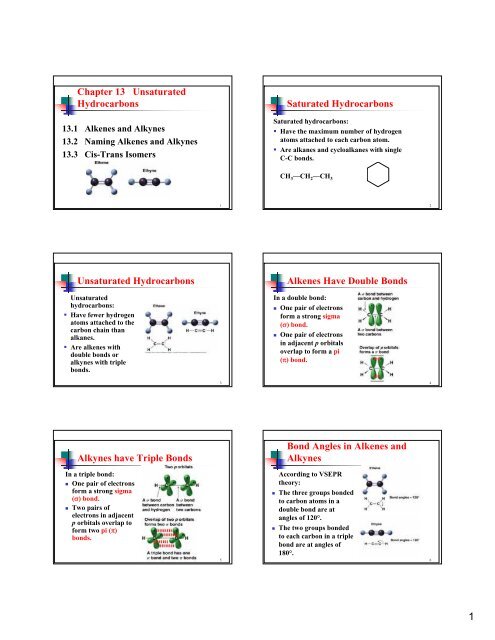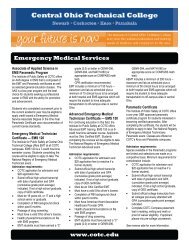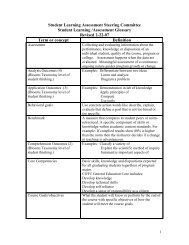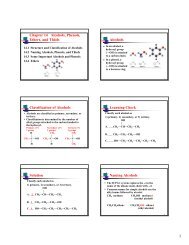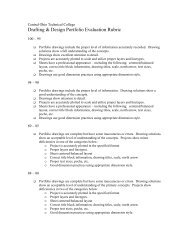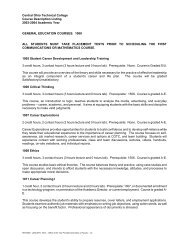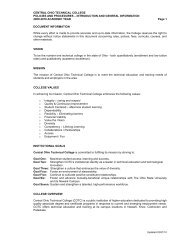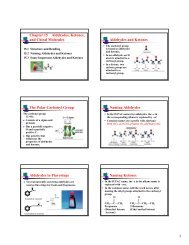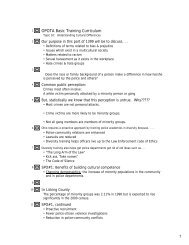Chapter 13 Unsaturated Hydrocarbons Saturated Hydrocarbons ...
Chapter 13 Unsaturated Hydrocarbons Saturated Hydrocarbons ...
Chapter 13 Unsaturated Hydrocarbons Saturated Hydrocarbons ...
You also want an ePaper? Increase the reach of your titles
YUMPU automatically turns print PDFs into web optimized ePapers that Google loves.
<strong>Chapter</strong> <strong>13</strong> <strong>Unsaturated</strong><br />
<strong>Hydrocarbons</strong><br />
<strong>13</strong>.1 Alkenes and Alkynes<br />
<strong>13</strong>.2 Naming Alkenes and Alkynes<br />
<strong>13</strong>.3 Cis-Trans Isomers<br />
<strong>Saturated</strong> <strong>Hydrocarbons</strong><br />
<strong>Saturated</strong> hydrocarbons:<br />
• Have the maximum number of hydrogen<br />
atoms attached to each carbon atom.<br />
• Are alkanes and cycloalkanes with single<br />
C-C bonds.<br />
CH 3 —CH 2 —CH 3<br />
1<br />
2<br />
<strong>Unsaturated</strong> <strong>Hydrocarbons</strong><br />
<strong>Unsaturated</strong><br />
hydrocarbons:<br />
• Have fewer hydrogen<br />
atoms attached to the<br />
carbon chain than<br />
alkanes.<br />
• Are alkenes with<br />
double bonds or<br />
alkynes with triple<br />
bonds.<br />
Alkenes Have Double Bonds<br />
In a double bond:<br />
• One pair of electrons<br />
form a strong sigma<br />
(σ) bond.<br />
• One pair of electrons<br />
in adjacent p orbitals<br />
overlap to form a pi<br />
(π) bond.<br />
3<br />
4<br />
Alkynes have Triple Bonds<br />
Bond Angles in Alkenes and<br />
Alkynes<br />
In a triple bond:<br />
• One pair of electrons<br />
form a strong sigma<br />
(σ) bond.<br />
• Two pairs of<br />
electrons in adjacent<br />
p orbitals overlap to<br />
form two pi (π)<br />
bonds.<br />
5<br />
According to VSEPR<br />
theory:<br />
• The three groups bonded<br />
to carbon atoms in a<br />
double bond are at<br />
angles of 120°.<br />
• The two groups bonded<br />
to each carbon in a triple<br />
bond are at angles of<br />
180°.<br />
6<br />
1
Naming Alkenes and Alkynes<br />
• In the IUPAC system, the –ane ending of the<br />
corresponding alkane is changed to –ene for<br />
alkenes and to –yne for alkynes.<br />
Naming Alkenes and Alkynes<br />
When the carbon chain has 4 or more C<br />
atoms, the chain is numbered to give the<br />
lowest number to the double or triple bond.<br />
1<br />
CH 2 =CH—CH 2 —CH 3 1-butene<br />
2<br />
CH 3 —CH=CH—CH 2 —CH 3 2-pentene<br />
3<br />
CH 3 —CH 2 —C≡C—CH 2 —CH 3 3 -hexyne<br />
7<br />
8<br />
Learning Check<br />
Write the IUPAC name for each:<br />
A. CH 3 —CH 2 —C≡C—CH 3<br />
CH 3<br />
|<br />
B. CH 3 —C=CH—CH 3 C.<br />
Solution<br />
Write the IUPAC name for each:<br />
A. CH 3 —CH 2 —C≡C—CH 3<br />
2-pentyne<br />
CH 3<br />
CH 3<br />
|<br />
B. CH 3 —C=CH—CH 3 C.<br />
2-methyl-2-butene 3-methylcyclopentene<br />
CH 3<br />
10<br />
9<br />
Cis-Trans Isomers<br />
• There is no rotation<br />
around the double bond<br />
in alkenes.<br />
• Groups attached to the<br />
double bond are fixed<br />
relative to each other.<br />
• You can make a “double<br />
bond” with your fingers<br />
with both thumbs on the<br />
same side or opposite<br />
from each other.<br />
11<br />
Cis-Trans Isomers<br />
• Two isomers are possible<br />
when groups are attached<br />
to the double bond.<br />
• In a cis isomer, groups are<br />
attached on the same side<br />
of the double bond.<br />
• In the trans isomer, the<br />
groups are attached on<br />
opposite sides.<br />
12<br />
2
Cis-Trans Isomers in Nature<br />
• Insects emit tiny quantities of pheromones,<br />
which are chemicals that send messages.<br />
• The silkworm moth attracts other moths by<br />
emitting bombykol, which has one cis and<br />
one trans double bond.<br />
Naming Cis-Trans Isomers<br />
• The prefixes cis or trans are placed in front of the<br />
alkene name when there are cis-trans isomers.<br />
Br<br />
H<br />
C<br />
C<br />
Br<br />
H<br />
Br<br />
H<br />
C<br />
C<br />
H<br />
Br<br />
cis-1,2-dibromoethene<br />
trans-1,2-dibromoethene<br />
<strong>13</strong><br />
14<br />
Cis-Trans Isomerism<br />
Learning Check<br />
• Alkenes cannot have cis-trans isomers if a<br />
carbon atom in the double bond is attached<br />
to identical groups.<br />
Identical<br />
H<br />
Br<br />
2-bromopropene<br />
H<br />
Identical<br />
Br<br />
C C<br />
C C<br />
H CH 3<br />
H Br<br />
1,1-dibromoethene<br />
15<br />
Name each, using cis-trans prefixes when needed.<br />
Br Br<br />
A. C C<br />
H H<br />
CH 3 H<br />
B. C C<br />
H CH 3<br />
CH 3 Cl<br />
C. C C<br />
H Cl<br />
16<br />
Solution<br />
<strong>Chapter</strong> <strong>13</strong> <strong>Unsaturated</strong><br />
<strong>Hydrocarbons</strong><br />
A.<br />
Br<br />
C<br />
H<br />
Br<br />
C<br />
H<br />
cis-1,2-dibromoethene<br />
<strong>13</strong>.4 Addition Reactions<br />
B.<br />
CH 3<br />
C<br />
H<br />
C<br />
H<br />
CH 3<br />
trans-2-butene<br />
C.<br />
CH 3<br />
C<br />
H<br />
C<br />
Cl<br />
Cl<br />
1,1-dichloropropene<br />
17<br />
18<br />
3
Addition Reactions<br />
Hydrogenation<br />
• The pi (π) bond is<br />
easily broken, which<br />
makes double and<br />
triple bonds very<br />
reactive.<br />
• In the addition<br />
reaction, reactants<br />
are added to the<br />
carbon atoms in the<br />
double or triple bond.<br />
19<br />
• In hydrogenation, hydrogen atoms add to the<br />
carbon atoms of a double bond or triple bond.<br />
• A catalyst such as Pt or Ni is used to speed up<br />
the reaction.<br />
H H<br />
H 2 C CH 2 +<br />
Pt<br />
H 2 C CH 2<br />
H 2<br />
HC CH + 2H 2<br />
Ni<br />
H<br />
HC<br />
H<br />
H<br />
CH<br />
H<br />
20<br />
Hydrogenation of Oils<br />
Learning Check<br />
• When hydrogen<br />
adds to the<br />
double bonds in<br />
vegetable oils, the<br />
products are<br />
solids at room<br />
temperature.<br />
Write the equation for the addition of<br />
hydrogen to 1-butene using a Ni catalyst.<br />
21<br />
22<br />
Solution<br />
Halogenation<br />
Write the equation for the addition of<br />
hydrogen to 1-butene using a Ni catalyst.<br />
CH 2 =CH—CH 2 —CH 3 + H 2<br />
Ni<br />
• In halogenation, halogen atoms add to the<br />
carbon atoms of a double bond or triple<br />
bond.<br />
Br Br<br />
H 2 C CH 2 +<br />
Br 2<br />
H 2 C CH 2<br />
Cl Cl<br />
CH 3 —CH 2 —CH 2 —CH 3<br />
HC C CH 3 + 2Cl H C C<br />
2<br />
Cl Cl<br />
CH 3<br />
23<br />
24<br />
4
Testing for Double and Triple<br />
Bonds<br />
• When bromine (Br 2 ) is<br />
added to an alkane, the<br />
red color of bromine<br />
persists.<br />
• When bromine (Br 2 ) is<br />
added to an alkene or<br />
alkyne, the red color of<br />
bromine disappears<br />
immediately.<br />
Learning Check<br />
Write the product of each addition reaction:<br />
Pt<br />
CH 2 =CH—CH 3 + H 2<br />
+ Br 2<br />
25<br />
26<br />
Solution<br />
Write the product of each addition reaction:<br />
Pt<br />
CH 2 =CH—CH 3 + H 2 CH 3 —CH 2 —CH 3<br />
Br<br />
Hydrohalogenation<br />
• In hydrohalogenation, the atoms of a hydrogen<br />
halide add to the carbon atoms of a double<br />
bond or triple bond.<br />
CH 3 CH CH CH 3 + HCl<br />
CH 3 CH CH CH 3<br />
H<br />
H<br />
Cl<br />
+ Br 2<br />
28<br />
Br<br />
+ HBr<br />
Br<br />
27<br />
Markovnikov’s Rule<br />
Hydration Adds Water<br />
• When an unsymmetrical alkene undergoes<br />
hydrohalogenation, the H in HX adds to the<br />
carbon in the double bond that has the greater<br />
number of H.<br />
CH 3 CH CH 2 + HCl<br />
H<br />
Cl<br />
CH 3 CH CH 2<br />
Does not form<br />
C with the most H<br />
Cl H<br />
CH 3 CH CH 2<br />
Product that forms<br />
29<br />
• In hydration, H and OH from water add to the<br />
carbon atoms of a double bond or triple bond<br />
to form alcohols (OH).<br />
• The reaction is catalyzed by acid H + .<br />
OH H<br />
H +<br />
CH 3 CH CH 2 + HOH CH 3 CH CH 2<br />
+ HOH<br />
H +<br />
H<br />
OH<br />
30<br />
5
Learning Check<br />
Write the products of each reaction.<br />
A. CH 3 CH CH 2 + Cl 2<br />
Solution<br />
Write the products of each reaction.<br />
Cl Cl<br />
A.<br />
+ Cl 2<br />
CH 3 CH CH 2<br />
B.<br />
CH 3 CH CH CH 3 + HOH<br />
H +<br />
B.<br />
H +<br />
CH 3 CH CH CH 3 + HOH<br />
H<br />
OH<br />
CH 3 CH CH CH 3<br />
C.<br />
+ H 2<br />
Pt<br />
C.<br />
CH 3 CH CH 2<br />
H<br />
+ H 2<br />
Pt<br />
H<br />
31<br />
32<br />
<strong>Chapter</strong> <strong>13</strong> <strong>Unsaturated</strong><br />
<strong>Hydrocarbons</strong><br />
<strong>13</strong>.5 Polymerization<br />
Polymers<br />
Polymers are:<br />
• Long-chain molecules.<br />
• Found in nature, including cellulose in<br />
plants, starches in food, proteins and<br />
DNA in the body.<br />
• Also synthetic such as polyethylene<br />
and polystyrene, Teflon, and nylon.<br />
33<br />
34<br />
Common Synthetic Polymers<br />
Polymerization<br />
• In polymerization, small repeating units called<br />
monomers are bonded to form a long chain<br />
polymer.<br />
H<br />
C<br />
H<br />
C<br />
H<br />
H<br />
H<br />
+ C C + C C<br />
H<br />
H<br />
H<br />
Ethylene monomers<br />
H<br />
H<br />
H<br />
H<br />
chain continues<br />
H<br />
H<br />
Repeating monomer<br />
C C C C C C<br />
H<br />
H<br />
H<br />
H<br />
H<br />
H<br />
H<br />
H<br />
H<br />
H<br />
chain continues<br />
35<br />
Polyethylene<br />
36<br />
6
Polymers from Addition Reactions<br />
More Monomers and Polymers<br />
37<br />
38<br />
Recycling Plastics<br />
Learning Check<br />
• Recycling is simplified by using codes on<br />
plastic items.<br />
1 PETE Polyethyleneterephtalate<br />
2 HDPE High-density polyethylene<br />
3 PV Polyvinyl chloride<br />
4 LDPE Low-density<br />
polyethylene<br />
5 PP Polypropylene<br />
6 PS Polystyrene<br />
• What is the starting monomer for polyvinyl<br />
chloride (PVC)<br />
H Cl H Cl H Cl<br />
C C C C C C<br />
H<br />
H<br />
H<br />
H<br />
H<br />
Polyvinyl chloride<br />
H<br />
39<br />
40<br />
Solution<br />
<strong>Chapter</strong> <strong>13</strong> <strong>Unsaturated</strong><br />
<strong>Hydrocarbons</strong><br />
• What is the starting monomer for polyvinyl<br />
chloride (PVC)<br />
H<br />
C<br />
C<br />
Cl<br />
H<br />
Cl<br />
H<br />
+ C C + C C<br />
Cl<br />
<strong>13</strong>.6 Aromatic Compounds<br />
H<br />
H<br />
H<br />
H<br />
H<br />
H<br />
Chloroethene monomers<br />
41<br />
42<br />
7
Aromatic Compounds<br />
Benzene is<br />
• An aromatic compound.<br />
• A ring of 6 C atoms and 6 H atoms.<br />
• A flat ring structure drawn with double bonds.<br />
• Represented by two structures because the<br />
electrons move among the C atoms.<br />
Benzene Structure<br />
• Because the pi electrons in benzene are shared<br />
equally among the 6 C atoms, benzene can<br />
also be represented as a hexagon with a circle<br />
drawn inside.<br />
43<br />
44<br />
Aromatic Compounds in Nature<br />
and Medicine<br />
Naming Aromatic Compounds<br />
• A benzene with a single substituent is often<br />
named as a benzene derivative.<br />
CH 3<br />
Cl<br />
Methylbenzene<br />
Chlorobenzene<br />
45<br />
46<br />
Some Common Names<br />
• Some substituted benzene rings have common<br />
names that have been in use for many years.<br />
CH 3 NH 2 OH<br />
Toluene Aniline Phenol<br />
(Methylbenzene) (Benzenamine) (Hydroxybenzene)<br />
47<br />
Naming Aromatic Compounds<br />
• A benzene ring with two or more substituents<br />
is numbered to give the lowest numbers to the<br />
side groups.<br />
• Common names use the prefixes ortho- (1,2-),<br />
meta- (1,3-) and para- (1,4-).<br />
Br<br />
Br<br />
Cl<br />
1,2-dimethylbenzene 1,3-dichlorobenzene 4-chloromethylbenzene<br />
(o-dibromobenzene) (m-dichlorobenzene) (p-chlorotoluene)<br />
48<br />
Cl<br />
CH 3<br />
Cl<br />
8
Learning Check<br />
Select the correct name for each structure:<br />
Solution<br />
Select the correct name for each structure:<br />
Cl<br />
1) chlorocyclohexane<br />
2) chlorobenzene<br />
3) 1-chlorobenzene<br />
Cl<br />
2) Chlorobenzene<br />
Cl<br />
Cl<br />
1) 1,3-dichlorobenzene<br />
2) o-dichlorobenzene<br />
3) m-dichlorobenzene<br />
Cl<br />
Cl<br />
1) 1,3-dichlorobenzene<br />
3) m-dichlorobenzene<br />
49<br />
50<br />
Learning Check<br />
Write the structural formula for each:<br />
A. 1-bromo-4-chlorobenzene<br />
Solution<br />
Write the structural formula for each:<br />
Cl<br />
A. 1-bromo-4-chlorobenzene<br />
B. o-chlorotoluene<br />
Br<br />
B. o-chlorotoluene<br />
CH 3<br />
Cl<br />
51<br />
52<br />
<strong>Chapter</strong> <strong>13</strong> <strong>Unsaturated</strong><br />
<strong>Hydrocarbons</strong><br />
<strong>13</strong>.7 Properties of Aromatic Compounds<br />
Benzene<br />
H<br />
+<br />
Cl 2<br />
FeCl 3<br />
Cl<br />
Chlorobenzene<br />
+<br />
HCl<br />
Properties of Aromatic<br />
Compounds<br />
Aromatic compounds:<br />
• Have a stable aromatic bonding system.<br />
• Are resistant to many reactions.<br />
• Undergo substitution reactions, which<br />
retains the stability of the aromatic<br />
bonding system.<br />
53<br />
54<br />
9
Substitution Reactions<br />
In a substitution reaction, a hydrogen atom on<br />
a benzene ring is replaced by an atom or group<br />
of atoms.<br />
Type of substitution H on benzene replaced by<br />
• Halogenation chlorine or bromine atom<br />
• Nitration nitro group (—NO 2 )<br />
• Sulfonation<br />
—SO 3 Hgroup<br />
Halogenation<br />
• Halogenation replaces a H on benzene by a<br />
chlorine or bromine atom.<br />
• A catalyst such as FeCl 3 is used in chlorination;<br />
FeBr 3 in bromination.<br />
Benzene<br />
H<br />
+<br />
Cl 2<br />
FeCl 3<br />
Cl<br />
Chlorobenzene<br />
+<br />
HCl<br />
55<br />
56<br />
Nitration<br />
• Nitration replaces a H on benzene by a nitro<br />
(—NO 2 ) group from HNO 3 .<br />
• An acid catalyst such as H 2 SO 4 is used in<br />
nitration.<br />
Sulfonation<br />
• Sulfonation replaces a H on benzene by a<br />
—SO 3 H group from SO 3 .<br />
• An acid catalyst such as H 2 SO 4 is used in<br />
sulfonation.<br />
H<br />
NO 2<br />
H<br />
SO 3 H<br />
+ HNO 3<br />
H 2 SO 4<br />
+<br />
HOH<br />
+<br />
SO 3<br />
H 2 SO 4<br />
Benzene<br />
Nitrobenzene<br />
Benzene<br />
Benzenesulfonic acid<br />
57<br />
58<br />
Learning Check<br />
Write the equation for the bromination of<br />
benzene, including catalyst.<br />
Solution<br />
Write the equation for the bromination of<br />
benzene, including catalyst.<br />
H<br />
Br<br />
+<br />
Br 2<br />
FeBr 3<br />
+<br />
HBr<br />
59<br />
60<br />
10


